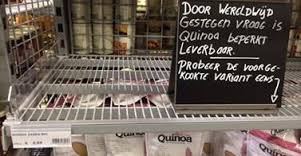The year 2014 started without vegetable protein. Dutch media announce on the 6th January what many traders claim to have foreseen for the international quinoa trade: Due to a worldwide over-demand for the golden grain, quinoa is scarce and supermarket shelves remain empty. Well-established companies like Lassie and new-comers like NatureCrops are out of stock and organic pioneer De Nieuwe Band has to increase its prices on a regular basis. But we want to know: what exactly is and has been happening on the market?
Fact is that prices have been increasing relentlessly since the early 2000s with 2013 representing the top of price-levels with increases of more than 100%. The price of $ 0.76 (G. Aroni, ANAPQUI 2013) for a whole bag of quinoa (which is equivalent to 46 kg) in 1980 is long forgotten. In January 2014, the price that a Bolivian farmer gets on the local market for one bag of quinoa is as high as $ 280 (That is $ 6.09 per kg!). The season had started with prices of $ 2 per kg. For international traders, the prices have increased equally drastically. Whereas a ton of quinoa was imported for $ 4000 in April 2013, the price in January 2014 is at around $ 9000.
It arises the famous question of the hen and the egg: Who has been there first? Which market dynamics influence the price? Is it the business attitude of South-American farmers that understand that they can ask high prices due to the international situation of supply and demand? Or is it the European and American market that create a tense market atmosphere and give export companies the chance to raise prices?
The truth is that some importers have been and are about to stop the quinoa business since it is not profitable anymore. Others are hoping for the beginning of the new season 2014 in which quinoa will be available in bigger quantities if looking at the expansion of quinoa production in South-American countries. Due to the high profitability for the quinoa producers, a migration back to the producing areas is at stake (P. Claver, 2014), promising a larger production of quinoa for the following season. Until then, supermarkets hope to maintain their customers suggesting them to try other Andean grains like amaranth.
Source: NOS/Leen Kraniotis, 06-01-2014

